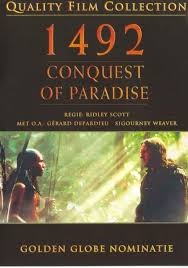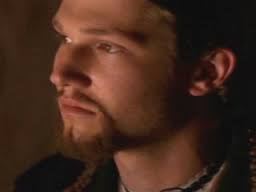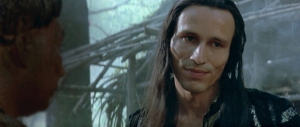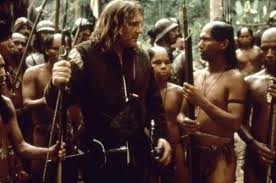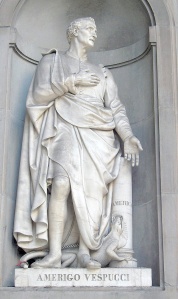In 1992, there was obvious interest in the anniversary of Columbus’ famous voyage of discovery, so not one but two films were released to cash in on public interest. Ilya Salkind’s Chrisopher Columbus: The Discovery faired quite poorly at the box office and was viewed as something of a fiasco. 1492: The Conquest of Paradise (dir. Ridley Scott) didn’t do very well at the box office either; apparently there was less interest than people thought (Americans not interested in history? What a shock!). But Scott’s film got somewhat better reviews, and it’s probably a little bit more remembered nowadays, so I’m going to tackle this one first. I’ll probably get around to the other film at some later date.
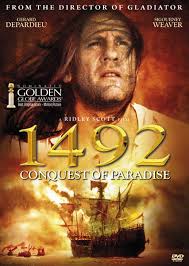
The Basic Problem with Columbus
The essential problem with telling Columbus’ story is that Americans tend to have a very strong idea of what it looks like, largely derived from high school history textbooks. And much of what these textbooks have to say about Columbus is crap.
In his 1995 book Lies My Teacher Told Me, James Loewen examined the most widely-used high school American history textbooks and studied both what percentage of their material was factually correct and how this material was presented to students. His conclusion is that a very high percentage of the material is either provably false or simply made-up speculation. In his chapter on Columbus, he offers a composite paragraph representing what these textbooks generally have to say, which I reproduce here; boldface portions are what scholars can actually say with reasonable certainty.
“Born in Genoa of humble parents, Christopher Columbus grew up to be an experienced seafarer, venturing as far as Iceland and West Africa. His adventures convinced him that the world must be round, and that sailing west could have the fabled riches of the East—spices and gold—, superseding the overland routes, which the Turks had closed off to commerce. To get funding for his enterprise, he beseeched monarch after monarch in Western Europe. After first being dismissed Isabella of Spain, Columbus finally got his chance when Isabella decided to underwrite a modest expedition. Columbus outfitted three pitifully small ships, the Niña, the Pinta, and the Santa Maria and set forth from Spain. After an arduous journey of more than two months, during which his mutinous crew nearly threw him overboard, Columbus discovered the West Indies on October 12, 1492. Unfortunately, although he made three more voyages to America, he never knew he had discovered a new world. Columbus died in obscurity, unappreciated and penniless. Yet without his daring, American history would have been very different, because in a sense he made it all possible.” (Loewen, p.54)
As you can see, more of the paragraph is speculation or falsehood than is fact. From your own education, you might remember details such as that the voyage involved heavy storms, that Columbus altered the logs of his journey, or that the crew was on the brink of mutiny when land was sighted. These are common details included in some high school textbooks, but they’re made up. The fact is that we don’t actually know much about the journey itself.
Most famously, you probably heard the story that everyone in Columbus’ day thought the world was flat and that it was possible to sail off the edge of the world. According to the story, Columbus was the first person to realize that the world was round. That’s crap too, made up by Washington Irving for his History of the Life and Voyages of Christopher Columbus, a three-volume historical novel published in 1828. Irving was consciously trying to create a patriotic American mythology, and he succeeded well enough to embed this myth of the flat earth in American minds still to this day. Mercifully, as Loewen points out, the textbooks have mostly abandoned this particular bit of nonsense.
The fact is that educated people and sailors have understood that the Earth is round since at least the 4th century BC or so. There are many ways to recognize the sphericity of the planet, including the curved shadow it casts on the moon during a lunar eclipse, the fact that where you are influences which constellations you can see, and the fact that when ships sail away from land, they gradually disappear from view hull-first. The reason that Europeans generally didn’t try sailing westward was that they understood that the circumference of the Earth is more than 22,000 miles. Since they didn’t know about the existence of the Americas, they assumed that the distance from Europe westward to Asia was too great to sail, because it would be impossible to take along enough fresh water for the entire journey. What is important about Columbus here is not that he figured out that the Earth was round, but that he miscalculated the circumference as being much less than it was, and he also thought that Japan was further to the east of China than it is. As a result, he estimated that the journey involved about 3,000 miles, rather than the nearly 20,000 miles it actually involves. So instead of being a brilliant geographer, he was actually quite a bad one.
The First Voyage of Gerard Depardieu
The first third of 1492: The Conquest of Paradise focuses, unsurprisingly, on the lead up to the first voyage of Christopher Columbus (Gerard Depardieu). The film does a delicate dance between the facts and the traditional narrative that Americans have been spoon-fed. It wants to include the stuff you learned in high school, but it doesn’t want to be blatant about it. Right at the start of the film, in 1491, we see Columbus teaching his young son Fernando. He shows Fernando how ships disappear out of view hull-first, and he illustrates the sphericity of the Earth using an orange. So the film implies the flat-earth story without actually asserting it. Young Fernando might plausibly think the Earth is flat, so Columbus teaching him the truth is technically accurate without the film having to claim that everyone thought the world was flat.
Soon he is informed that a friendly monk has arranged for him to have a meeting with the faculty of the University of Salamanca to present his radical theories (in reality, the meeting happened 6 years earlier, because Queen Isabella had already agreed to patronize him). The film shows the faculty understanding that the world is round; they cite Aristotle and Ptolemy’s calculations that the world was too large to allow sailing westward to Asia (actually the calculations are those of Eratosthenes of Cyrene, but at least they’re in the ball-park). In reply, Columbus cites Pierre D’ailly and a few other medieval authorities and argues that the world is smaller than the ancient calculations. So the film gives a reasonably accurate depiction of what the issues are, although it doesn’t explain that Columbus’ figures are woefully wrong. He’s the hero, and he did actually get to the Americas, so explaining that he was wrong and got lucky is sort of embarrassing. But the refusal to acknowledge this seriously distorts at least two scenes in the film, including this one.
Because the film can’t admit that Columbus was mistaken, the uninformed viewer is likely to take away from the scene that the faculty were wrong when in fact they are basically correct. The scholars are depicted as arrogantly mocking Columbus and refusing to consider new ideas. But since Columbus is the hero and must be right, even though his arguments are actually wrong, the scholars opposing him must be wrong and therefore bad, even though they’re actually right. And this, unfortunately, is the basic tone this part of the film takes. Everything Columbus does is good, even though in fact he’s wrong. It makes analyzing the film a little maddening because black is white and down is up.
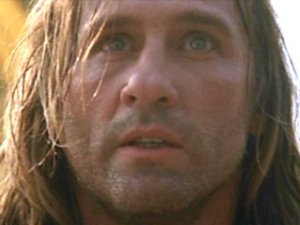
Even Depardieu can’t figure out what the film is trying to say
Not long after he is turned down, Columbus is approached by Martín Pinzón, a shipmaster who offers to support him. In reality, it was Columbus who approached Pinzón and had to win his support. Pinzón was a skilled mariner who, according to some French stories, had already discovered the Americas four years earlier. He and his two brothers captained the Pinta and the Niña, vessels they owned, and they provided a very substantial sum of money to fund the voyage. They also recognized that the ships and crew that Columbus has arranged for were inadequate and entirely dismissed them. So these three brothers deserve a great deal of the credit for the success of the voyage. But in the film, Martin Pinzón is depicted essentially as a follower (in the words of Carla Rahn Phillips and William D. Phillips, Jr, as a “supportive sidekick”), and his brothers don’t really feature at all.
Just before the voyage, Columbus confesses to his priest that he’s been lying to everyone. He doesn’t actually know how long the journey is. All he knows is that he’s right. The priest angrily tells him that he must tell all the sailors, and when Columbus refuses he threatens to tell the men himself, until Columbus reminds him that he cannot speak about matters he hears in confession. Columbus demands absolution, and the priest gives it to him.
This scene is incredibly problematic. Its obvious purpose is to ratchet up the drama; Columbus is having a crisis of confidence that he needs to work through, and the revelation of his uncertainty raises the stakes for the journey itself. But it’s pointless and made-up drama; the audience knows he’s going to make it. So really all it does it cast Columbus in the mold of the Heroic Individual. He can’t prove he’s right; he just knows he is. What matters is not anything as unimportant as science; what matters is that he’s certain he’s right (except that he’s not actually certain). And he’s not actually right, because he’s completely miscalculated the distance. What saves him is the fortunate existence of the Bahamas, not his certainty that he can get to Asia. So he’s totally wrong, but thinks he’s right even though he doesn’t know he’s right, but his certainty carries him through and he’s rewarded for being certain but wrong! My head hurts just trying to understand what this scene is actually saying. But I guess we’ve always been at war with Eastasia.
And then there’s the wrongness of the theology in this scene. The priest forgives him even though Columbus is still actively committing a sin and risking the lives of all the sailors in the bargain. In Catholic theology, confession only merits absolution if the sinner is penitent and sincerely intends to amend his sin, but Columbus is demanding forgiveness for a sin he’s still actively committing and refusing to give up. But, if it’s one thing I’ve learned in writing this blog, it’s that the medieval clergy just make everything up as they go along, so Columbus gets his absolution basically for being pushy.
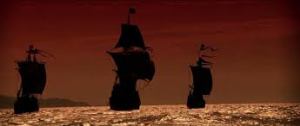
The journey itself manages to avoid most of the textbook clichés about the journey. There’s no storms, there’s a little lesson on how a quadrant is used in navigation, and there’s some nice details about life on board a ship. Pinzón gets anxious and Columbus has to point out that there’s not enough water left to turn around and get home. Then he has to persuade a nervous crew that they need to have faith in God and themselves, and that if they succeed, future generations will talk about how brave they all were. That does the trick, despite not being a very good speech. Then Columbus gets bitten by an insect and realizes they must be near land because I guess they don’t have bugs out at sea.
The actual landfall is nicely done. Instead of someone shouting “land!” as your high school textbook probably had it, the ship drifts through a fog bank and then a lush jungle emerges out of the mists in a really beautiful peace of photography that briefly manages to capture what must have been a genuine sense of wonder about the new land they’ve just arrived at. In some ways, it’s the best moment in the whole film.
What’s nice about this film is, unlike your high school textbook’s story about Columbus, the film’s story is only about a third over. The film is actually far more interested in what happened after Columbus arrived than what it took to get there. But that’s for another post.
Want To Know More?
Read James Loewen’s Lies My Teacher Told Me: Everything Your American History Textbook Got Wrong Reprint Edition by Loewen, James W. published by Touchstone (2007) Paperback. No, seriously. Read it. It’s a necessary corrective to a lot of the nonsense in American history textbooks, especially since the Texas Board of Education started getting the final say in what goes into high school textbooks. If I were ever going to teach an American history class, I think I’d use this as my textbook. If you teach high school history, you pretty much have to read this. You might also look at Loewen’s Teaching What Really Happened: How to Avoid the Tyranny of Textbooks and Get Students Excited About Doing History (Multicultural Education Series).
If you want a biography of Columbus, one of the better ones is Kirkpatrick Sale’s Christopher Columbus and the Conquest of Paradise: Second Edition (Tauris Parke Paperbacks). But Sale isn’t a historian, and is not always as objective as he ought to be. So read with caution.
But Sale isn’t a historian, and is not always as objective as he ought to be. So read with caution.
Oh, yeah. 1492: Conquest of Paradise is available on Amazon.
is available on Amazon.







is available on Amazon.

